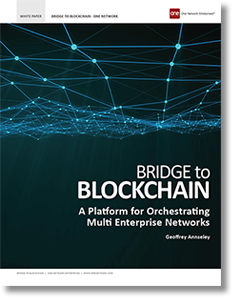Blockchain Technology and the Real-Time Global Supply Chain

Achieving secure, high-performance supply chains requires the marrying of performance and permissibility with the transparency and trust of blockchain technology, by combining blockchain with a proven network platform, companies today can integrate blockchain with supply chain networks.
What is Blockchain?
Blockchain has traditionally been the technology underlying the cryptocurrency Bitcoin.
Blockchain was developed as a distributed technology that maintains an ongoing, ordered record, and is a distributed, open, and immutable ledger.
Since the distribution is unique, each record is independently constructed and not centrally governed, meaning the data is an open record and duplicated to all parties within the blockchain.
Being open, anyone can read it and anyone can write to it.
Benefits of Blockchain
The major benefits of Blockchain are:
- It allows data to be shared among multiple parties with full transparency and trust
- Parties do not need to rely on a central authority to manage and validate data and transactions
- It is tamper-proof, there is no way to fraudulently modify the data as it is replicated across thousands if not millions of machines.
This is a definite advantage within the supply chain, as it remains a traceable record of engagement for all transactions.
Blockchain and Supply Chain Management
The vast majority of today’s supply chains are sequential and siloed.
Since large amounts of data are copied and passed up and down the chain via batch processing, data takes a long time to propagate throughout the supply chain.
This slows down operations that are driven by the data, and causes a supply-demand mismatch, creates excess inventory, out of stocks, and high logistics costs when stock needs to be moved quickly for replenishment.
By taking the data out from behind the walls of the enterprise, Blockchain enables a near-real-time, digital supply chain with a single version of the truth.
This removes lag, speeds up the supply chain, and reduces inventory and operating costs while improving service to the end customer.
Despite the potential that Blockchain brings to the supply chain, there are challenges with using it to run the supply chain today.
Blockchain Confidentiality
The openness of Blockchain has a major disadvantage when it comes to the supply chain.
Most companies do not want their trading partners and external parties having access to their data.
There have been many attempts to solve this problem by “partitioning” blockchains and using Blockchain “micro-communities”, but none of them have created a practical solution that works in the context of the supply chain. (For a detailed look at the problem and the proposed solutions, download How Blockchain Can Revolutionize the Supply Chain.)
Blockchain Scalability
The second major difficulty that Blockchain has within the supply chain is scalability.
Consider the vast quantity of transactions that occur across a global supply chain, involving products, locations, and numerous business partners.
In order for a supply chain to be responsive to demand the technology must process these transactions in near real time.
This poses a major challenge to Blockchain, which has a relatively low transaction rate. Consider the transaction rates of major financial networks.
VISA handles an average of about 2,000 transactions per second (VISA Fact Sheet 2015). PayPal, with a much smaller network, handles 115 tps (according to its 2014 financial report). Blockchain’s transaction rate is around 10 tps.
“I believe scalability will be the primary bottleneck for the [Blockchain] industry for the foreseeable future.” – Fred Ehrsam, (Co-Founder Coinbase)
Blockchain’s transaction rate needs to be a lot higher before Blockchain is ready to manage today’s fast moving global supply chains that involve sales of millions of products across thousands of locations.
Making Blockchain Supply Chain Ready
Blockchain can play a role in the supply chain, where confidentiality and scalability are not concerns; but in order to realize its full value, these key problems must be solved.
Multi-party networks have solved both of these problems.
This opens up the possibility of combining Blockchain with a proven network platform, which enables companies to get the best of both Blockchain and Networks.
Here’s a brief explanation of how this works.
Restoring Confidentiality to the Supply Chain with Blockchain
Sensitive data and transactions should not be accessible to everyone on the blockchain.
A multi-party network uses a multi-dimensional permissions framework to ensure that the thousands of parties on the network only have access to the data that they are entitled to.
So for example, a buyer, seller, and carrier can collaborate around a single transaction, with the carrier seeing the item number and quantity, but not the price. While the buyer and seller see item number, quantity and price.
On this multi-party network model, sensitive transactions that should remain private, are handled by an “Orchestrator” that manages an “Orchestrated Blockchain”. This managed Blockchain works in parallel with a standard Blockchain.
This enables the Blockchain-enabled Network to achieve many things that are not possible with a pure Blockchain. But the biggest benefit is that complex, multi-party transactions that are common in the supply chain, such as between a buyer, seller, and carrier can be optimized and orchestrated while maintaining full confidentiality for all parties’ data.
Blockchain Scaling for Real-Time Global Supply Chains
Similarly, the most advanced multi-party networks have solved the scalability problem with horizontally scalable grid architecture.
This allows the network to process a high volume of transactions in near real time.
These networks can process around 1000 transactions per second, far in excess of Blockchain’s rate and perfectly capable of processing the large amounts of data and transactions required to manage and optimize a global supply chain.
What's Missing from Blockchain?
Another considerable benefit of networks is that they can provide functionality beyond the ledger and smart contracts.
Multi-party networks can provide industry-specific data models and functionality, so companies can get up and running quickly, whether they are defense organization managing ammunition, or a pharmaceutical company managing medicine.
Advanced multi-party networks also provide full-featured, multi-party apps that integrate planning and execution, and enable buyers, suppliers and logistics companies to collaborate in real time.
Artificial intelligence, machine learning, and IoT can run across the network, optimizing, automating and streamlining the end-to-end supply chain, not just operations within an organization, or between immediate trading partners.
One Network’s ONE Blockchain™ is the marrying of performance and permissibility with the transparency and trust of Blockchain.
Related Article Bridge to Blockchain: The Enterprise Journey
Related Blockchain White Papers
Bridge to Blockchain: A Platform for Orchestrating Multi-Enterprise Networks New!
In this white paper, you will learn why blockchain platforms vary widely in terms capability, disclosure, confidentiality, anonymity, the cost to use, and speed, and why companies need to leverage more than one blockchain network to realize game-changing business models. Download Now!
Can Blockchain Revolutionize the Supply Chain?
In this white paper Ranjit Notani, One Network CTO examines Blockchain’s powerful potential as well as a major problem and whether and how Blockchains can revolutionize the Supply Chain. Download Now!
More Resources on Blockchain
Article Topics
One Network Enterprises News & Resources
Blue Yonder announces an agreement to acquire One Network Enterprises for $839 million Blue Yonder Acquires One Network Enterprises for $839M Companies Need to Develop New Innovative Approaches to Supply Chain Design How to Improve Cost of Goods Sold Horizontally Across the Supply Chain How the Global Pandemic Accelerated Supply Chain Visibility, Digitalization, and Automation AI and Data, the Future of Supply Chain Management AI and Supply Chain Problem Solving More One Network EnterprisesLatest in Technology
Spotlight Startup: Cart.com Walmart and Swisslog Expand Partnership with New Texas Facility Taking Stock of Today’s Robotics Market and What the Future Holds Biden Gives Samsung $6.4 Billion For Texas Semiconductor Plants Apple Overtaken as World’s Largest Phone Seller Walmart Unleashes Autonomous Lift Trucks at Four High-Tech DCs Talking Supply Chain: Procurement and the AI revolution More Technology
















